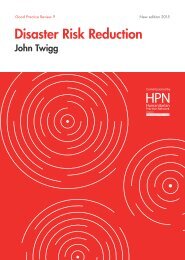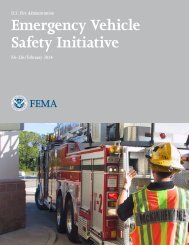Observer
2aEAQDf
2aEAQDf
You also want an ePaper? Increase the reach of your titles
YUMPU automatically turns print PDFs into web optimized ePapers that Google loves.
in the event of a natural hazard may be valuable. Similarly,<br />
pre-establishing local residents that can serve as adverse<br />
event “consultant” to run formal risk-communication<br />
messaging can alleviate tensions and misunderstandings<br />
in an event. This approach can create a pre-established<br />
channel for the exercise of political capital. What these vignettes<br />
suggest is that formal governmental structure is a<br />
key resource that must often be utilized for post disaster<br />
recovery. How citizens and communities draw on political<br />
capital should continue to be considered and explored.<br />
With more attention to this distinct concept and how it relates<br />
to other drivers, communities and citizens can take<br />
individual or collective action to improve post disaster recovery.<br />
Flint Water Plant © June 2016 George Thomas<br />
mised health among children since 2014 when the water<br />
supply was switched.<br />
Walters and Hanna-Attish together called attention to<br />
the lead content of the water supply. 4 Both individuals are<br />
repeatedly cited by the media as igniting local citizens,<br />
leading to national concern, and federal involvement on<br />
the issue. These two women drew on their political capital<br />
to help illicit a national response to the water crisis in<br />
Flint. Although it likely took human capital in the strength<br />
of character of each person, and social capital to gain the<br />
support of other local residents, it was through their vertical<br />
reach to government, an exercise in political capital,<br />
change was able to be enacted.<br />
Future directions<br />
Political capital is a newly defined concept for post-event<br />
recovery. Further research is needed into how it can specifically<br />
be operationalized and measured. Thinking about<br />
the capitals mentioned in this article—economic capital,<br />
human capital, political capital, and social capital—as<br />
distinct resources individuals can draw on in an adverse<br />
situation, allows citizens, practitioners, and researchers<br />
to design more nuanced interventions before and after disasters.<br />
For example, given the success of LTRGs, creating<br />
community committees that work with county governance<br />
4 Leanne Walters and Dr. Mona Hanna-Attish Testimony: http://abcnews.<br />
go.com/US/flint-mother-emotional-testimony-water-crisis-affectedchildrens/story?id=38008707<br />
References<br />
Abramson, D. M., Grattan, L. M., Mayer, B., Colten, C. E., Arosemena,<br />
F. A., Rung, A., & Lichtveld, M. 2015. "The Resilience Activation Framework:<br />
A conceptual model of how access to social resources promotes<br />
adaptation and rapid recovery in post-disaster settings" The Journal of<br />
Behavioral Health Services & Research, 42(1), 42–57. Aldrich, D. P. 2012.<br />
"Social Capital in Post Disaster Recovery: Towards a Resilient and Compassionate<br />
East Asian Community", in Sawada, Y. and S. Oum (eds.),<br />
Economic and Welfare Impacts of Disasters in East Asia and Policy Responses.<br />
ERIA Research Project Report 2011-8, Jakarta: ERIA. pp.157-178.<br />
National Volunteer Organizations Active in Disasters (VOAD). 2012.<br />
National VOAD Long Term Recovery Guide. http://www.nvoad.org/<br />
wp-content/uploads/2014/05/long_term_recovery_guide_-_final_2012.<br />
pdf (accessed on June 23, 2016)<br />
Ocean County Long Term Recovery. Website. http://oceancountyltrg.<br />
org/ Sandy Child and Family Health Study (SCAFH). 2014. SCAFH<br />
Status Report 1. http://ncdp.columbia.edu/custom-content/uploads/2014/07/Status-Report-1FINAL_21Jul2014_v2.pdf<br />
(accessed on<br />
June 23, 2016)<br />
Author<br />
Rachael Piltch-Loeb is a<br />
junior research scientist at NYU’s<br />
College of Global Public Health’s<br />
Program on Population Impact, Recovery,<br />
and Resilience and a doctoral<br />
student. Piltch-Loeb has been a part<br />
of the program from its inception at NYU, working on<br />
projects related to health, well-being, and long-term recovery<br />
from disasters, especially Superstorm Sandy. She<br />
received her masters degree from the Bloomberg School<br />
of Public Health at Johns Hopkins University and her undergraduate<br />
degree from Georgetown University. Piltch-<br />
Loeb’s current research interests are in interdisciplinary<br />
public health systems improvement.<br />
Natural Hazards <strong>Observer</strong><br />
ISSN 0737-5425<br />
Printed in the USA.<br />
Published bimonthly. Reproduction with acknowledgment is permitted and encouraged.<br />
Back issues of the <strong>Observer</strong> are available for $4.00 each, plus shipping and handling. Orders must be prepaid. Checks should be<br />
payable to the University of Colorado. Most major credit cards are also accepted.<br />
Subscribe to the <strong>Observer</strong> and the Natural Hazard Center’s electronic newsletter, DR-Disaster Research News You Can Use, at:<br />
https://hazards.colorado.edu/observer/subscriptions<br />
Natural Hazards <strong>Observer</strong> • June 2016 31







